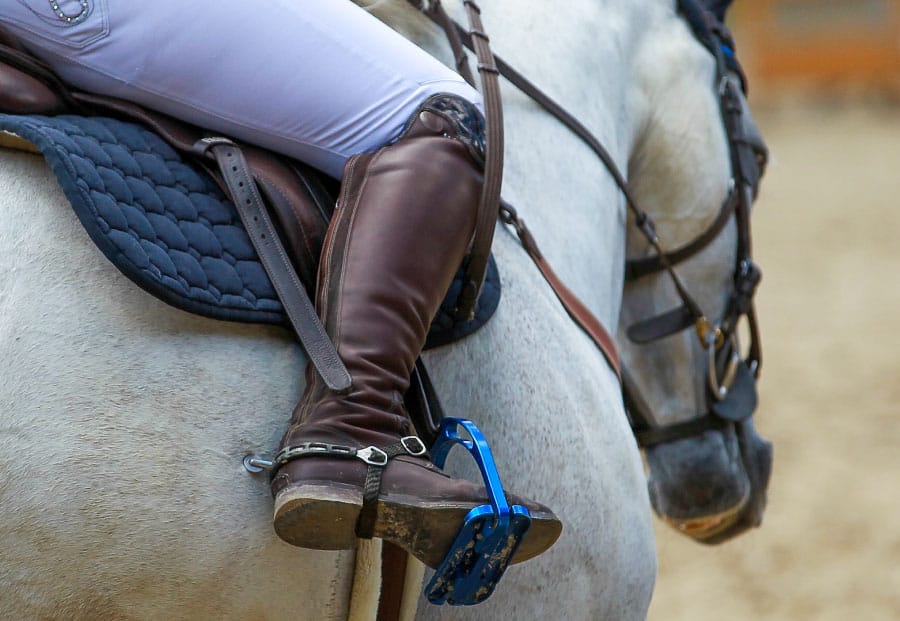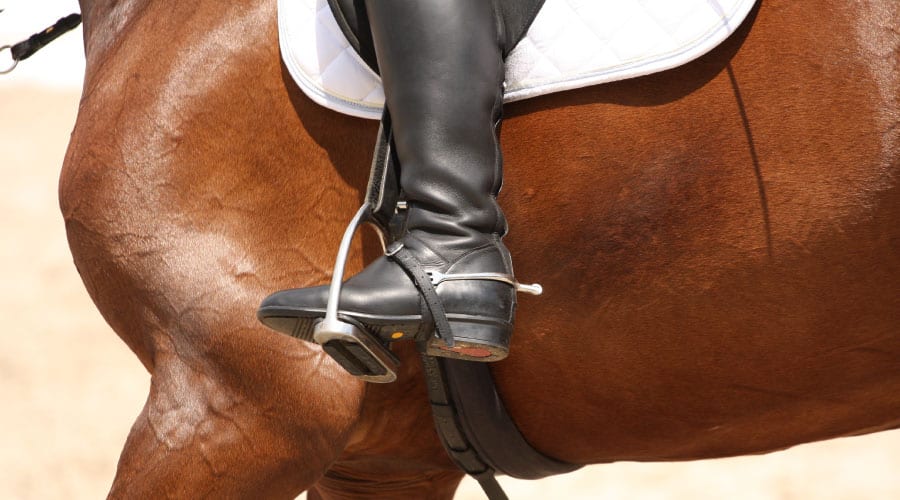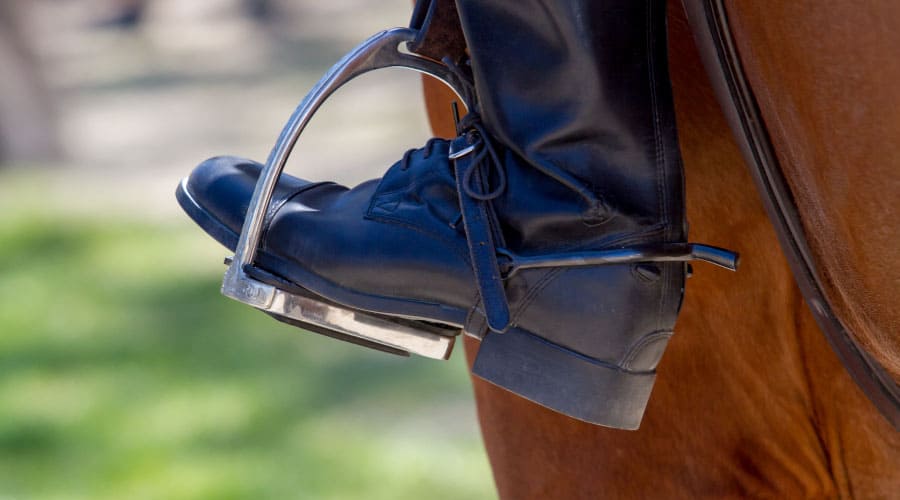- Your source for stall mats, rubber arena footing, arena harrows and arena dust control.

Ever wondered why show jumpers wear spurs? Why would you need them and what are they used for? Spurs are not only commonly used in show jumping but across many other equestrian disciplines like dressage and eventing. So why do show jumpers use spurs as part of their gear ?
?
Spurs are used in show jumping as training aids to direct a horse to move forward while riding. Spurs enhance the leg aid and make a horse more reactive to a rider’s legs, enabling the rider to adjust the horse quickly between fences. Spurs are also used to back up a rider’s natural aids such as their legs, seat, hands, and voice.
So let’s examine exactly how and why spurs are used in show jumping, how to use it correctly and also situations when the use of spurs is bad.
Use of spurs in show jumping
The main reason for riding with a spur is to get your horse to move forward. When you apply leg pressure, you are asking the horse to go forward and move away from your leg.
More responsive leg aid
Show jumpers need to be able to move forward and back quickly when jumping a track, so riders need to be able to adjust their horses easily between fences and to adjust quickly, your horse should be reactive and responsive to your legs. Some horses are sensitive to a rider’s leg aids while other horses will make you work hard to achieve the desired pace.
Using spurs provides you with a sharper leg aid which means your horse will react quicker. If your horse is lazy off the leg and you have to constantly nag them to go forward, using a spur can help fix the problem by making them more sensitive to your leg aids.
Gives your horse confidence
Spurs can give a horse confidence in uncertain situations. For example, if a horse is backing off the fence, then applying pressure with the spur will let the horse know you are supporting him and provide encouragement to jump the fence.
Horses are, by nature, flight animals and when they are spooky at a jump or feeling nervous into a fence, they might not even realize the added leg pressure coming from your heels.
Adding a spur can enhance the aid so your horse can feel the aid more clearly, even with all the adrenalin pumping during the round.
Helps with leg precision in the flat
When training your horse on the flat, using spurs can be a helpful tool in achieving correctness. Proper use of spurs is about giving better communication and can assist in giving clear and precise leg aids. Spurs give precision from the leg aids that are needed for training proper flying changes, leg yield and shoulder in (All lateral work).
You must first understand how to properly perform these aids without the spur before incorporating them to avoid confusion and incorrect training.
Rules for the use of spurs in show jumping
As with whips, the use of spurs is tightly regulated in showjumping competitions. It differs from country to country, but a rider may only use spurs when the neck of the spur is under a certain length, the spur is smooth with no sharp edges, rollers are smooth and able to rotate.
Penalties and sanctions are imposed when spurs are used excessively or harshly.
How to wear and use spurs correctly?
Spurs come in different shapes, sizes, and lengths. Choosing what spur to use generally comes down to a rider’s preference, what you want to achieve and the discipline you are riding in.
Spurs should be placed around your ankles and on top of your heel bone. The Spur straps should be tied with the buckle facing to the outside of your boot. The neck of the spur should curve downwards and must never be facing up.

Spurs must be strapped on tight enough and not move around or slip down when riding, to avoid the spur catching the horse wrong or giving incorrect and confusing leg aids.
When riding with spurs, you should ensure the correct position and control of your lower leg. Your foot should face parallel to your horse’s side with toes pointing forward. Your toes should not be pointing out when using spurs as this will result in overuse.
Spurs should be used to nudge a horse or by tapping a horse with your spur. Apply one or two strides of spur pressure, followed by releasing the pressure. Continuous use of the spur against a horse without releasing is excessive and can break the horse’s skin.
When to use spurs?

Just because you see riders wear spurs does not mean they are using them. Riders do not need to use spurs all the time but it is better to have them in the ring to back up the leg if needed, then needing them and not having them.
Training
When schooling a young horse and once you have established the understanding that the legs mean ‘go forward’, using a spur can enhance a young horse’s training and understanding. It is important that a horse has covered some basic schooling correctly before incorporating spurs into their training. When a horse lacks an understanding of the basics, using a spur will only complicate things for the horse and lead to confusion.
Reinforcement
When you have a horse that is lazy or has become desensitized to your leg aids, using a spur will make your horse reactive to your aids. Correct use of the spur is important because you should never have to nag a horse.
Sometimes you find that you still need to nag them even though you are wearing a spur. In this case, using a whip as reinforcement might be better as you should never have constant spur pressure.
When your horse feels nervous in the ring or has lost confidence when jumping for some reason, using a spur can be used as positive reinforcement from the leg aids.
Accuracy
When refining your schooling, spurs can give your leg aids more accuracy and precision when working your horse on the flat. Show jumpers spend a lot of time schooling a horse on the flat to achieve balance and suppleness.
When are spurs bad?

It is true that Spurs are sharp aids but that does not mean they are painful for horses. Spurs can be considered inhumane if not used correctly.
When spurs are used by inexperience riders
Spurs should only be used once a rider has established the proper leg position and has complete control over their lower leg. When a rider has “loose legs”, they will constantly jab the horse in the sides. A rider should be able to keep their lower legs still before attempting to use spurs.
When spurs are used as punishment
Spurs are bad when a rider jabs a horse in the ribs and generate pain as a way of punishing the horse for something. Using spurs should never cause the skin to break.
In most show jumping competitions a rider would get penalized for taking their frustrations out by kicking the horse hard in the ribs when wearing spurs. A rider would also be disqualified if found that the use of a spur broke a horse’s skin, whether intentional or not.
When spurs are used incorrectly
When a rider is applying constant pressure with the spur without release, this is seen as harsh and excessive use of the spurs, not to mention that the constant pressure of the spur would rub on the horse’s sides causing the skin to break.
It is the responsibility of the rider to ensure that spurs are correctly fitted and positioned on their boots before mounting the horse. Spurs that are loose or sitting incorrectly positioned around a rider’s ankle could lead to miscommunication between the horse and rider as well as breaking of the skin.
There should be no visible marks on a horse indicating that a rider wore spurs. Swelling, rubbing the hair off and broken skin or bleeding are all signs that a rider has overused or incorrectly used their spurs.
Other posts in this series to check out:
Can You Jump in a Dressage Saddle?
Do Show Jumpers Wear Body Protectors?
Why Do Show Jumpers Wear Ear Covers?

